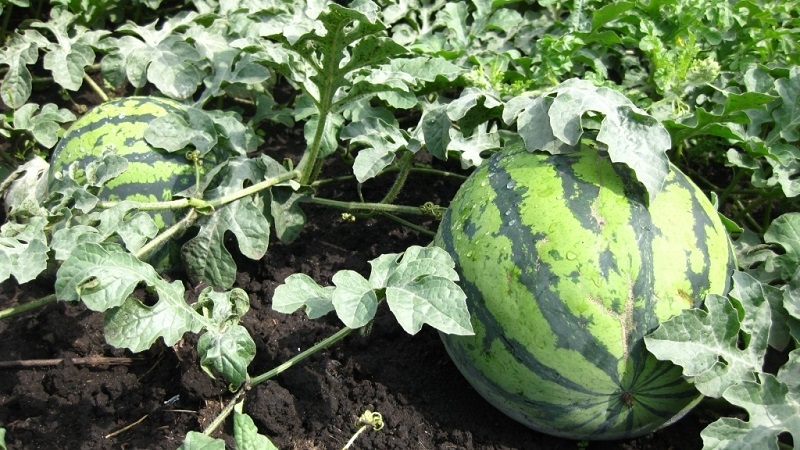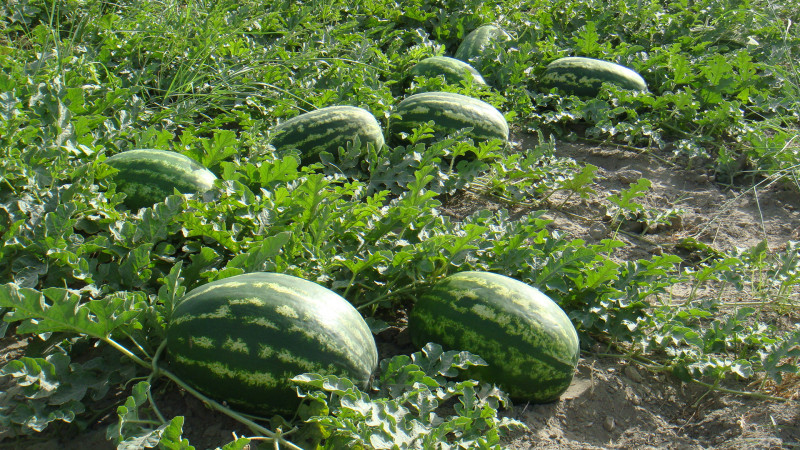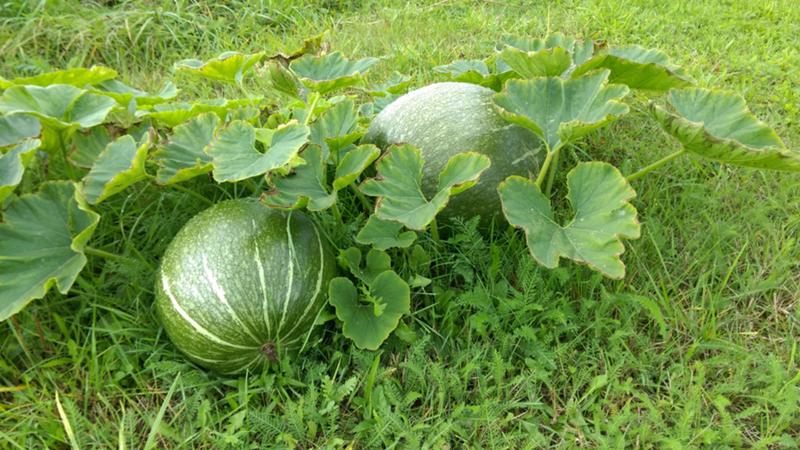How, when and how to feed watermelons to get a stunning sweet harvest
Often, summer residents strive to surprise their relatives and neighbors with their garden achievements. Often, melons become the object of effort, because, for example, it is difficult to grow a sweet watermelon in central Russia. However, there are masters who harvest delicious fruits annually. Using their experience and advice, try to grow sweet and juicy watermelons in your country house.
The content of the article
How to feed watermelons
Top dressing is of great importance for obtaining a good harvest of watermelons. If you observe the dosage, sequence and timeliness, you can achieve the correct development of plants and abundant fruiting.
The taste of grown watermelons depends on several factors, including the introduction of complex fertilizers containing a set of macro- and microelements. The compositions of potassium, magnesium and boron are especially important: their lack dramatically affects the deterioration of the taste of berries.

In the greenhouse
In the greenhouse, only early-ripening varieties and hybrids, zoned for a specific area, fully ripen. It is better to purchase seeds from trusted sellers, focusing on the production date.
The fresher the planting material, the faster the seedlings will appear and the plants will begin to develop. It is impractical to use the seeds left from the purchased watermelon: they are unlikely to sprout and give a crop. Sowing for seedlings is carried out in the 2nd decade of April.
The landing technology consists of several stages:
- To check the germination, the seeds are dipped in a salt solution prepared from 1 tsp. salt for 1 tbsp. water. Pop-up instances are empty, they are removed.
- The rest are washed with running water and placed in a 1% solution of potassium permanganate for 30 minutes. Then they are washed again.
- Before sowing, to stimulate growth, soak in a solution of "Zircon" or "Epin".
- The soil is prepared in advance: for 1 bucket of prepared soil from an equal amount of garden soil and compost, add 1 tbsp. l. urea, 1-2 tbsp. l. superphosphate and 1 tbsp. l. potassium sulfate.
- A separate container with a diameter of 10–12 cm is prepared for each seed, since watermelons are very sensitive to injury during transplantation.
- Seeds are placed at a depth of 0.5–1 cm and covered with foil. The optimum temperature for germination is + 30 ° C. Under these conditions, the first shoots appear in 2-3 days. Deviations from the temperature norm are undesirable: with higher values there is a risk that the seeds will germinate later or die, with lower sprouts they do not develop.
After germination, the room temperature is maintained at + 22 ... + 25 ° C. Watermelons are short-day plants, so when growing seedlings maintain 12-hour daylight hours. In this case, flower buds are laid on time and further development of sprouts occurs. In urban apartments, the illumination level is insufficient, therefore phytolamps are used, seedlings are sprayed with growth stimulants.
Water the seedlings only with warm, settled water when the topsoil dries up. When 3-4 true leaves are formed, weekly fertilizing with complex mineral fertilizers begins.
Important! When cultivating watermelons in a greenhouse, make sure that its height allows you to grow climbing plants with a height of at least 2 m.Polycarbonate greenhouses are popular among gardeners.
They begin to prepare the soil for planting seedlings when warm weather is established up to + 20 ° C in the daytime and at least + 5 ° C at night.
The height of the ridges is 40–45 cm. A week before planting, the top layer of soil is removed, manure, hay, sawdust or wood chips are placed in the resulting trench, and nutritious soil is poured over it. The constructed ridges are spilled with a solution of potassium permanganate for disinfection. If possible, heating pipes with hot water are laid at the base of the ridge. In this case, you don't have to worry about temperature conditions.
For seedlings, holes are prepared with a depth of 10 cm with a distance between them of at least 50 cm. The soil in the containers is moistened and the plant with a lump of earth is carefully removed. The seedling is positioned so that the root collar rises above the ground. The soil is watered and immediately mulched with a layer of hay or sawdust.
Important! The optimum temperature for watermelons in the greenhouse is + 26 ... + 30 ° C with a decrease at night to + 18 ° C; air humidity - 55-60%.
Watering melons and gourds 1 time in 7-10 days with settled warm water, trying not to get on the root collar and leaves. The reference point for moisture is slight wilting of the leaves. When creating drip irrigation, it is easy to maintain optimal air humidity, which is especially important during the formation and growth of fruits. During this period, watering is stopped altogether in order to accelerate the process of ripening and accumulation of sugars.
The first feeding of watermelons in the greenhouse is carried out when the plant height reaches 25–30 cm. For this, fertilizers with prolonged action or traditional fertilizers are used, with the obligatory introduction of potassium salts or ash. A good option is Kemira, which contains a complex of trace elements. 1 tbsp. l. the funds are dissolved in 10 liters of warm settled water and watered at the rate of 0.5 liters per plant. "Kemira" can be replaced with a solution of mullein or urea with the addition of 1 tbsp. wood ash.
During growth, the culture is fertilized once every 2 weeks, during the period of formation and development of fruits - once a week. The bushes are sprayed with solutions of "Zircon" or "Epin", alternating them. When forming ovaries, watermelons are treated with "Bud" or "Ovary", otherwise you will have to manually pollinate. They do this in the morning, picking a male flower and applying it to a female one, making several circular movements.
When growing watermelons, trellises are used, tying up the plants so that they do not shade each other. The lateral stems are pinched, since in the northern regions watermelons bear fruit only on the main stem. 3-4 ovaries are left on it, all the rest are removed so that the first fruits have time to ripen.
The central shoot is pinched after 4-6 leaves, the last ovary... This method speeds up the ripening of watermelons, but the fruits become smaller. If the summer is warm, this procedure is not carried out. Each ovary is placed in a polyethylene net, which is fixed on a trellis, since the lashes may not support the weight of the fruit.
Ripe fruits are removed selectively, focusing on the beginning of drying out of the lash sections. The harvest is stored at a temperature of + 12 ° C (at lower rates, the berries rot).
In the open field

To create favorable conditions for growing crops in the garden, a well-lit, warm place, sheltered from the winds, is selected. It is best to place a watermelon ridge in the southern or southeastern part of the site.
The soil is dug up in autumn and 0.5 buckets of rotted manure, 40 g of superphosphate, 25–35 g of ammonium sulfate and 20–25 g of potassium sulfate per 1 m2 are added. In the spring, for every 5 liters of soil, additional 100 g of double superphosphate, 50-60 g of dolomite flour, 55 g of potassium sulfate and 55 g of ammonium nitrate are added. By the time of planting, the soil should be warmed up to a depth of 10 cm, and the air temperature should be up to + 15 ° C. This usually happens in the last days of May.
A distance of 1–1.5 m is left between the holes, passages up to 2 m are made between the rows. Seedlings prepared for a greenhouse are planted with a lump of earth to cotyledon leaves.The soil around is covered with sand to a height of 10 cm. Everyone is watered with warm water. Until the seedlings take root and begin to grow, they are covered with a film or non-woven material stretched over arcs.
In 2 weeks after planting watermelons are fed with solutions of urea, mullein or chicken droppings. When the ovaries are formed, a mixture of 4 g of calcium chloride, 4 g of ammonium nitrate and 6 g of superphosphate is introduced.
All the time they monitor the level of soil moisture, since when it rises, the plants are exposed to various fungal diseases.
The best mineral supplements
If a crop is not fertilized in a timely manner, it stops developing and withers away. For the cultivation of watermelons, both already known and new types of dressings are used.
When planting seedlings, 6 granules of "AVA" fertilizer are added to each hole, which gradually dissolves in the soil and acts throughout the season.
In the process of growing watermelons, potash and boron compounds are introduced: Boro Plus, Green-Go, Kelik Potassium, Crystalon, Mag-Bor, Terraflex and others.
Organic fertilizers

When cultivating watermelons, gardeners often use unconventional dressings, for example, a yeast preparation prepared in the form of mash. Yeast contains a whole complex of microelements that improve the quality and presentation of the fruit, contributing to the rapid development of the root system.
To prepare top dressing, 100 g of yeast is placed in a container (10 l) and filled with 3 l of water. Add a little sugar or old jam. The mixture is used after a week, adding 1 tbsp. in 10 liters of water. Pour 1 liter of solution under each plant.
A dressing made from bread crumbs works in a similar way. The mass is poured with water in a ratio of 1: 7 and watermelons are watered once a week.
From organic compounds, manure, bird droppings, compost are used.
Root and foliar feeding
Foliar dressing is used in the form of solutions that are sprayed over the green mass of watermelons. The products allow plants to get nutrients faster. The same method is used to treat watermelons with biological products (for example, "Fitosporin-M"), which help fight diseases.
Root dressing is applied traditionally by watering the crop.
Selection of fertilizers depending on the growth phase
At each stage of development, watermelons need different nutrients.
For seedlings
When growing seedlings, their growth is stimulated, therefore, urea is introduced in the form of a solution (1 tbsp. L. Per 10 l of warm water).
Gardeners use cow and poultry droppings in a ratio of 1:10. A mixture of 1 tbsp is prepared from wood ash. 10 liters of water.
The first top dressing is applied when 2 true leaves are formed, the second - 10-15 days before transplanting the seedlings to a permanent place.
After transplant
After transplanting, the seedlings adapt to new conditions, therefore they need additional nutrition only after 10-15 days. At this time, use 20 g of nitrate per 10 liters of water, watered with 2 liters per plant.
A good top dressing is a mixture of organic and mineral fertilizers. To do this, dissolve manure (1:10) or chicken droppings (1:20) in water, add 30 g of double superphosphate and 15 g of potassium chloride. 1-2 liters of the mixture are consumed for each bush.
Many gardeners use "green" fertilizer for feeding, enriching it with ash or chicken droppings. Grass fermented for 2 weeks is poured over watermelons, using 1 liter per root.
During flowering
For the formation of ovaries, plants need potassium. In a 200 l barrel, dissolve 2 kg of Nutrivanta Plus, watered with 1 l per plant. In the same way, a mixture is prepared from magnesium nitrate (2 kg per 1 barrel) or from "Kelik Potassium" (0.5 l per 1 barrel).
To form a larger number of ovaries, the culture is treated with boric acid, dissolving it in hot water (0.1 g per 1 tbsp.), And then adding clean warm liquid to a volume of 5 liters. Leaves are sprayed with this solution.
When fruiting
At this stage, the complex fertilizer "Uniflor Micro" is suitable (2 tsp of the product is dissolved in 10 liters of warm water).
Apply a mixture of 1 tbsp.l. superphosphate, 1 tbsp. l. "Azofoski" and 1 tsp. potassium sulfate, pouring 1 liter per bush.
Top dressing in summer and autumn
When fruit grows, gardeners use the Terraflex Universal solution at the rate of 7 g per 10 liters of warm water. The product contains nitrogen in a nitrate form, which is quickly absorbed by the root system.

What fertilizers increase the fruit
To increase the size of striped berries, wood ash is used, that is, obtained from the burning of twigs and branches. The product has a good effect not only on the size, but also on the taste of watermelons, making them sweeter.
In one variant of preparation, 200 g of ash is poured with 1 bucket of water and insisted for a week. In another, 1 kg of ash is poured into 10 liters of water and boiled for 15 minutes. When watering, dilute in a ratio of 1:10.
To grow faster
Crop growth is stimulated by mullein, chicken droppings, green manure and yeast mash. Korean agronomists advise adding a spoonful of saltpeter to our traditional remedies. Top dressing is repeated after 1-2 weeks, consuming a matchbox of the substance for 10 liters of warm water.
Mineral deficiency signals
Plants show by their appearance the lack of a particular nutrient. So, with a lack of nitrogen, the growth of the culture slows down, inflorescences are formed small and poorly developed, the leaves brighten, the veins become yellow.
The lack of phosphorus in the right amount affects the poor growth of the root system, the simultaneous crushing of the leaves and their acquisition of a dark green color with a purple tint. Plants noticeably lag behind in growth, with a delay they form ovaries.
Potassium influences fruit ripening and yield. With its lack, the bushes weaken, they are affected by fungal infections. In the absence of this element at the time of ovary formation, the fruits may not form at all.
When and how often to fertilize
Watermelon is a food demanding crop throughout the growing season. Timely introduced nutrients contribute to the proper development and fruiting of plants.
Fertilizers are applied in the form of root and foliar dressings throughout the development of watermelons, every 10-15 days until ripening.
Useful Tips

Outdoor plants are well pollinated by insects. To attract them, the bushes are sprinkled with sugar syrup.
For uniform ripening of fruits on hot days, they are gently turned to the sun, but at the very beginning of ripening they are shaded with newspapers or burdock leaves.
A plank or a piece of plastic is placed under each berry so that the crop does not rot from contact with the ground. 2-3 handfuls of sand are poured at the root collar.
It is better to water the crop in very hot weather and in the furrows between the rows, so that the roots grow in breadth, and not in depth and do not rot.
Reviews of gardeners
Farmers grow watermelons not only in the southern regions, but also in the Moscow region, and in Siberia... Here are some of the reviews.
Olesya, Irkutsk: «Wonderful watermelons. I can say with confidence that they grow not only in the Moscow region, but also in Siberia. Not as big as in Astrakhan, of course, but no less sweet. Variety Spark has proven itself the best. I have no experience in growing melons, I have not tried it yet, but I plant watermelons directly in the ground, in a seedless way. I noticed that the seedlings are sick for a long time during the pick. "
Andrey, Novaya Ladoga: “I experimented with late plantings last year. I planted grafted watermelons on one ridge, but planted them in the ground at the beginning of June without film and shelters so that they could ripen. I took unpretentious early hybrids and varieties: Prince Albert (yellow-brown), Skorik, Knyazhich. On the other side of the field, I planted it in a row with just seeds in the ground under the arcs Ultraranny, SRD-2, Knyazhich. In late April - early May, the seeds sprouted. I removed the film from the arcs in early June. Knyazhich distinguished himself by the powerful growth of the tops. This means that his root system developed better than others. "
Conclusion
Getting a harvest of large and sweet watermelons in central Russia is not easy, but possible.For this, suitable varieties are chosen, only high-quality seeds are purchased, and cultivation techniques are followed.
In order for the fruits to grow sugar and large, a warm, lighted place is prepared for melon. Throughout the season, fertilizers are applied in a timely manner, the bushes are regularly watered without waterlogging.